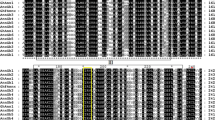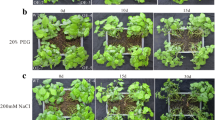Abstract
Transgenic cotton (Gossypium hirsutum L.) lines expressing the tobacco glutathione S-transferase (GST) Nt107 were evaluated for tolerance to chilling, salinity, and herbicides, antioxidant enzyme activity, antioxidant compound levels, and lipid peroxidation. Although transgenic seedlings exhibited ten-fold and five-fold higher GST activity under normal and salt-stress conditions, respectively, germinating seedlings did not show improved tolerance to salinity, chilling conditions, or herbicides. Glutathione peroxidase (GPX) activity in transgenic seedlings was 30% to 60% higher under normal conditions, but was not different than GPX activity in wild-type seedlings under salt-stress conditions. Glutathione reductase, superoxide dismutase, ascorbate peroxidase, and monodehydroascorbate reductase activities were not increased in transgenic seedlings under salt-stress conditions, while dehydroascorbate reductase activity was decreased in transgenic seedlings under salt-stress conditions. Transgenic seedlings had 50% more oxidized glutathione when exposed to salt stress. Ascorbate levels were not increased in transgenic seedlings under salt-stress conditions. Malondialdehyde content in transgenic seedlings was nearly double that of wild-type seedlings under normal conditions and did not increase under salt-stress conditions. These results show that expression of Nt107 in cotton does not provide adequate protection against oxidative stress and suggests that the endogenous antioxidant system in cotton may be disrupted by the expression of the tobacco GST.









Similar content being viewed by others
Abbreviations
- APX:
-
Ascorbate peroxidase
- DHAR:
-
Dehydroascorbate reductase
- GSH:
-
Reduced glutathione
- GSSG:
-
Oxidized glutathione
- GPX:
-
Glutathione peroxidase
- GR:
-
Glutathione reductase
- GST:
-
Glutathione S-transferase
- MDA:
-
Malondialdehyde
- MDHAR:
-
Monodehydroascorbate reductase
- ROIs:
-
Reactive oxygen intermediates
- SOD:
-
Superoxide dismutase
References
Bartling D, Radzio R, Steiner U, Weiler EW (1993) A glutathione S-transferase with glutathione peroxidase activity from Arabidopsis thaliana: molecular cloning and functional characteristics. Eur J Biochem 216:579–586
Bayley C, Trolinder N, Ray C, Morgan M, Quisenberry JE, Ow DW (1992) Engineering 2,4-D resistance into cotton. Theor Appl Genet 83:645–649
Blum A (1988) Plant Breeding for Stress Environments. CRC Press, Boca Raton FL USA
Boyer JS (1982) Plant productivity and environment: potential for increasing crop plant productivity, genotypic selection. Science 218:443–448
Bradford MM (1976) A rapid and sensitive method for the quantitation of microgram quantities of protein utilizing the principle of protein-dye binding. Anal Biochem 72:248–254
Browne RW, Armstrong D (1998) Reduced glutathione and glutathione disulfide. In: Armstrong D (ed) Methods in molecular biology, vol. 108: Free radical and antioxidant protocols. Humana Press, Totowa, pp 347–352
Cakmak I, Strbac D, Marschner H (1993) Activities of hydrogen peroxide-scavenging enzymes in germinating wheat seeds. J Exp Bot 44:127–132
Demmig-Adams B, Adams WW III (1996) The role of xanthophyll cycle carotenoids in the protection of photosynthesis. Trends Plant Sci 1:21–26
Droog FNJ, Hooykaas PJJ, Libbenga KR, van der Zaal EJ (1993) Proteins encoded by an auxin-regulated gene family of tobacco share limited but significant homology with glutathione S-transferases and one member indeed shows in vitro GST activity. Plant Mol Biol 21:965–972
Edwards R, Dixon RA (1991) Glutathione S-cinnamoyl transferases in plants. Phytochemistry 30:79–84
Ellis MH, Millar AA, Llewellyn DJ, Peacock WJ, Dennis ES (2000) Transgenic cotton (Gossypium hirsutum) over-expressing alcohol dehydrogenase shows increased ethanol formation but no increase in tolerance to oxygen deficiency. Aust J Plant Physiol 27:1041–1050
Flohe L, Gunzler WA (1984) Assay of glutathione peroxidase. In: Packer L (ed) Methods of Enzymology, vol. 105: Oxygen Radicals in Biological Systems. Academic, Orlando, pp 114–121
Foyer CH, Noctor G (2001) The molecular biology and metabolism of glutathione. In: Grill D, Tausz M, De Kok LJ (eds) Significance of Glutathione to Plant Adaption to the Environment. Kluwer, Dordrecht, p 43
Hatkios KK (2001) Functions and regulation of plant glutathione S-transferases. In: Hall JC, Hoagland RE, Zablotowicz RM (eds) Pesticide biotransformation in plants and microorganisms: similarities and divergences. American Chemical Society, Washington, pp 218–239
Hatton PJ, Cole DJ, Edwards R (1996) Influence of plant age on glutathione levels and glutathione transferases involved in herbicide detoxification in corn (Zea mays L.) and giant foxtail (Setaria faberi Herrm). Pest Biochem Phys 54:199–209
Hérouart D, Van Montagu M, Inzé D (1993) Redox-activated expression of the cytosolic copper/zinc superoxide dismutase gene in Nicotiana. Proc Natl Acad Sci USA 90:3108–3112
Hodges DM, De Long JM, Forney CF, Prange RK (1999) Improving the thiobarbituric acid-reactive-substances assay for estimating lipid peroxidation in plant tissues containing anthocyanin and other interfering compounds. Planta 207:604–611
Kang WH, Kim JH, Lim JD, Yu CY (2002) Overexpression of cotton glutathione S-transferase (GST) cDNA and increase of low temperature and salt tolerance in plants. J Plant Biotechnol 4:17–122
Klapheck S, Zimmer I, Cosse H (1990) Glutathione and ascorbate participate in hydrogen peroxide degradation in germinating castor bean endosperm. In: Rennenberg H, Brunold C, DeKok LJ, Stulen I (eds) Sulfur nutrition and sulfur assimilation in higher plants. SPB Academic Publishing, The Hague, p 202
Lamb C, Dixon RA (1997) The oxidative burst in plant disease resistance. Annu Rev Plant Physiol Plant Mol Biol 48:251–275
Marrs KA (1996) The functions and regulation of glutathione S-transferases in plants. Ann Rev Plant Physiol Plant Mol Biol 47:27–58
Marrs KA, Alfenito MR, Lloyd AM, Walbot V (1995) A glutathione S-transferase involved in vacuolar transfer encoded by the maize gene Bronze-2. Nature 375:397–400
McGonigle B, Lau S-MC, Jennings LD, O’Keefe DP (1998) Homoglutathione selectivity by soybean glutathione S-transferases. Pest Biochem Phys 62:15–25
Mozer TJ, Tiemeier DC, Jaworski EG (1983) Purification and characterization of corn glutathione S-transferase. Biochem 22:1068–1072
Nakano Y, Asada K (1981) Hydrogen peroxide is scavenged by ascorbate-specific peroxidase in spinach chloroplasts. Plant Cell Phys 22:867–880
Payton P, Webb R, Korneyeyev D, Allen R, Holaday AS (2001) Protecting cotton photosynthesis during moderate chilling at high light intensity by increasing chloroplastic antioxidant enzyme activity. J Exp Bot 52:2345–2354
Pekker I, Tel-Or E, Mittler R (2002) Reactive oxygen intermediates and glutathione regulate the expression of cytosolic ascorbate peroxidase during iron-mediated oxidative stress in bean. Plant Molecular Biol 49:429–438
Rajguru SN, Banks SW, Gossett DR, Lucas MC, Fowler TE Jr, Millhollon EP (1999) Antioxidant response to salt stress during fiber development in cotton ovules. J Cotton Sci 3:11–18
Roxas VP, Smith RK, Allen ER, Allen RD (1997) Overexpression of glutathione S-transferase/glutathione peroxidase enhances the growth of transgenic tobacco seedlings during stress. Nature Biotech 15:988–991
Roxas VP, Lodhi SA, Garrett DK, Mahan JR, Allen RD (2000) Stress tolerance in transgenic tobacco seedlings that overexpress glutathione S-transferase/glutathione peroxidase. Plant Cell Physiol 41:1229–1234
Schröder P (2001) The role of glutathione and glutathione S-transferases in plant reaction and adaption to xenobiotics. In: Grill D, Tausz M, De Kok LJ (eds) Significance of glutathione to plant adaption to the environment. Kluwer, Dordrecht, p 169
Sen Gupta A, Webb RP, Holaday AS, Allen RD (1993) Overexpression of superoxide dismutase protects plants from oxidative stress: induction of ascorbate peroxidase in SOD over-expressing plants. Plant Physiol 103:1067–1073
Smith IK (1985) Stimulation of glutathione synthesis in photorespiring plants by catalase inhibitors. Plant Physiol 79:1044–1047
Smith IK, Vierheller TL, Thorne CA (1988) Assay of glutathione reductase in crude homogenates using 5, 5′dithiobis(2-nitrobenzoic acid). Anal Biochem 175:408–413
Stahl RL, Liebes LF, Farber CM, Silber R (1983) A spectrophotometric assay for dehydroascorbate reductase. Anal Biochem 131:341–344
Ukeda H, Maeda S, Ishii T, Sawamaura M (1997) Spectrophotometric assay for superoxide dismutase based on tetrazolium salt 3′-{1-[Phenylamino)-cabonyl]-3,4-tetrazolium}-bis(4-methoxy-6-nitro)benzensulfonic acid hydrate reduction by xanthine-xanthine oxidase. Anal Biochem 251:206–209
Wagner U, Edwards R, Dixon DP, Mauch F (2002) Probing the diversity of the Arabidopsis glutathione S-transferase gene family. Plant Molecular Biol 49:515–532
Wingsle G, Karpinski S (1996) Differential redox regulation by glutathione of glutathione reductase and CuZn-superoxide dismutase gene expression in Pinus sylvestris L. needles. Planta 198:151–157
Acknowledgements
This work was supported by a grant from the Southwest Consortium for Plant Genetics and Water Resources and the Texas Advanced Technology Program.
Author information
Authors and Affiliations
Corresponding author
Rights and permissions
About this article
Cite this article
Light, G.G., Mahan, J.R., Roxas, V.P. et al. Transgenic cotton (Gossypium hirsutum L.) seedlings expressing a tobacco glutathione S-transferase fail to provide improved stress tolerance. Planta 222, 346–354 (2005). https://doi.org/10.1007/s00425-005-1531-7
Received:
Accepted:
Published:
Issue Date:
DOI: https://doi.org/10.1007/s00425-005-1531-7




